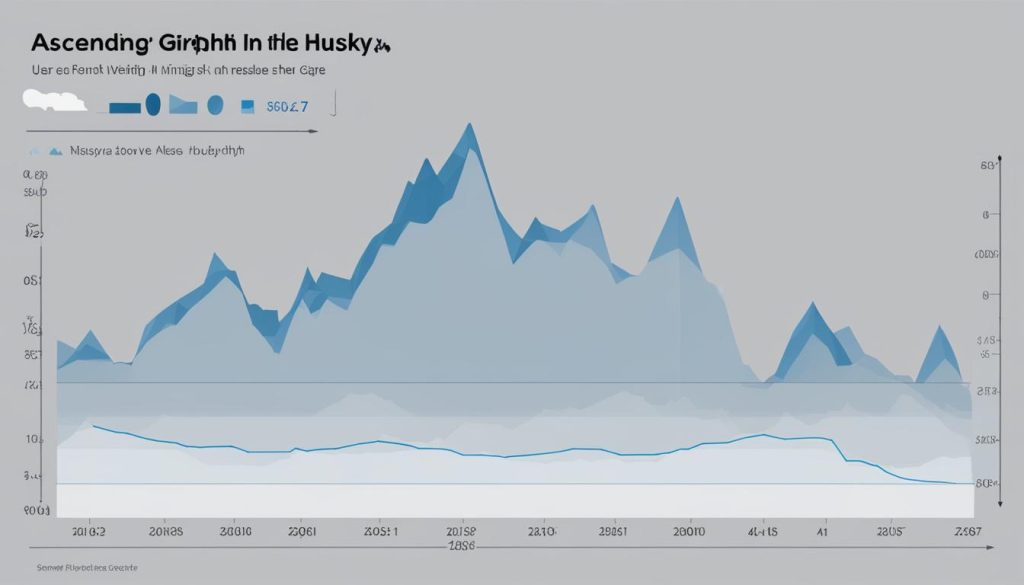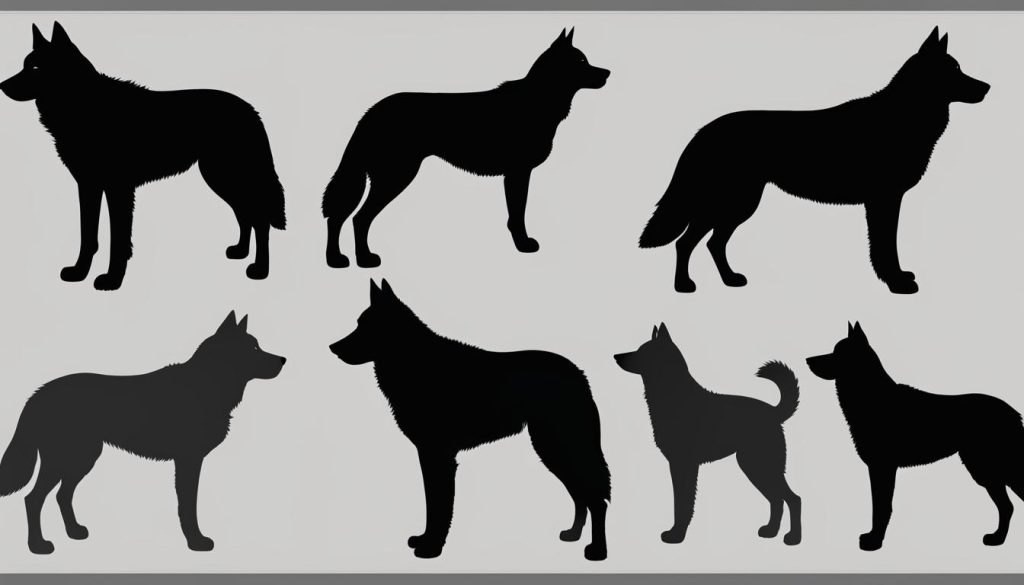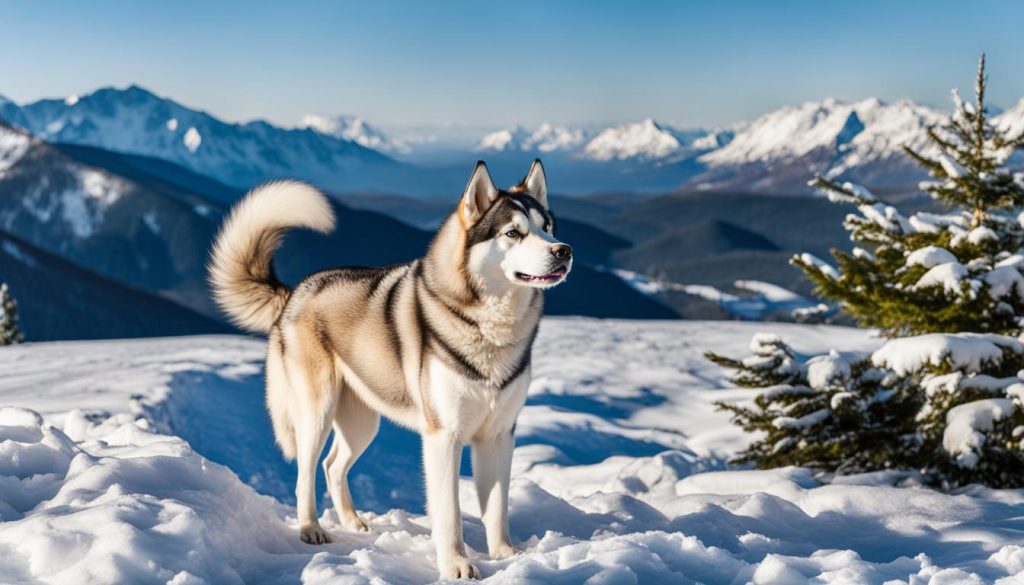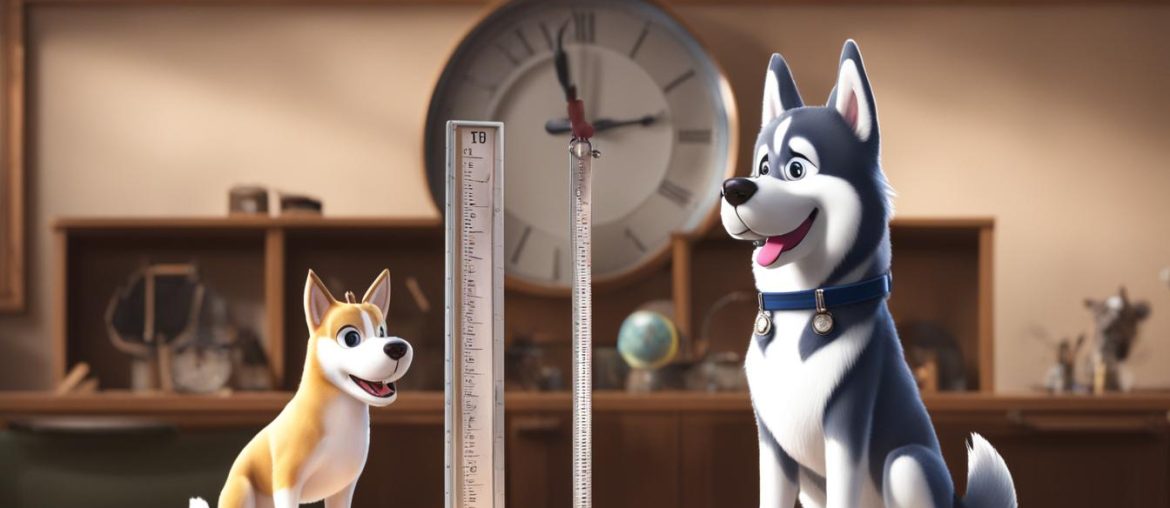Siberian Huskies are known for their graceful appearance, almond-shaped eyes, and being relatively clean dogs. To track the growth of a Siberian Husky, a growth chart can be used. The chart provides information on the weight and size of a Husky at different ages. According to the chart, male Huskies usually weigh between 45 and 60 pounds, while females weigh between 35 and 50 pounds. They are considered fully grown around their first birthday, although they may continue to fill out their chest for a few more months. By 15 months old, a Husky should be fully grown and at a healthy weight for their body size.
Key Takeaways:
- Siberian Huskies are fully grown around their first birthday
- Male Huskies usually weigh between 45 and 60 pounds, while females weigh between 35 and 50 pounds
- Huskies may continue to fill out their chest for a few months after their first birthday
- A Husky should be fully grown and at a healthy weight by 15 months old
- Regular veterinary check-ups are important to ensure a Husky’s growth and development
Siberian Husky Growth & Weight Chart

The Siberian Husky growth chart provides valuable insights into the weight and size development of Huskies at different ages. It serves as a helpful tool for owners to track their Husky’s growth progress and ensure they are achieving healthy milestones throughout their development.
Let’s take a closer look at the weight ranges provided by the Siberian Husky growth chart:
| Age | Males (Weight in pounds) | Females (Weight in pounds) |
|---|---|---|
| 1 month | 3 – 5 | 2 – 6 |
| 6 months | 30 – 40 | 25 – 33 |
| 1 year | 45 – 60 | 35 – 50 |
| 2 years | 45 – 60 | 35 – 50 |
It’s important to note that the weight ranges provided in the growth chart are estimates based on averages. Individual Huskies may vary slightly from these figures due to factors such as genetics, diet, and exercise. Consulting with a veterinarian can provide more personalized guidance on your Husky’s growth and weight.
At What Age is a Siberian Husky Fully Grown?
Siberian Huskies are considered fully grown around their first birthday. However, it may take a few more months for them to finish filling out their chest. By 15 months old, most Huskies should be fully grown and reach their full height. It’s important to consult with a veterinarian to ensure that a Husky is at a healthy weight for their body size.
Proper nutrition and veterinary care play a crucial role in a Husky’s growth and development. It’s essential to provide them with a balanced diet and monitor their weight to ensure they are reaching their full size appropriately. Regular check-ups with a veterinarian can help confirm if a Husky has reached their full growth potential and ensure they are in optimal health.
How Big Should a 6-Month-Old Siberian Husky Be?

At 6 months old, a male Siberian Husky should weigh around 30 to 40 pounds, while a female Siberian Husky should weigh between 25 to 33 pounds. During this stage, Husky puppies experience rapid growth and should be provided with regular exercise, a balanced diet, and appropriate veterinary care to support their development.
It is important to monitor the growth of your 6-month-old Husky to ensure they are within the healthy weight range for their age. Regular weigh-ins and consultations with a veterinarian can help you track their growth progress and make any necessary adjustments to their diet or exercise routine.
Proper nutrition is key during this stage of development. Provide your Husky with a high-quality puppy food that is specifically formulated for their nutritional needs. It should contain the right balance of protein, fat, and other essential nutrients to support healthy growth and development.
Regular exercise is also important for a 6-month-old Husky. They have a lot of energy and need opportunities to expend it. Engage in daily activities such as walks, playtime, and mental stimulation exercises to keep them physically and mentally stimulated.
Additionally, ensure that your Husky receives regular veterinary care. This includes vaccinations, deworming, and routine check-ups to monitor their overall health and development. A veterinarian can detect any potential health issues early on and provide appropriate treatment.
Overall, providing your 6-month-old Husky with proper nutrition, regular exercise, and veterinary care will help them reach their full growth potential and ensure they develop into healthy adult dogs.
How Much Bigger Will My Siberian Husky Get?

The size a Siberian Husky will reach depends on several factors. Generally, Huskies continue to grow until about 12 to 18 months old, but at a much slower rate compared to the first few months of their life. Factors that can influence their size include genetics, age, and paw size. If a Husky puppy has large paws compared to their body size, it may indicate that they still have some growing left to do.
How Big is a Full-Grown Siberian Husky?

When it comes to the size of a full-grown Siberian Husky, it is important to consider the breed standards set by the American Kennel Club (AKC). These standards provide guidelines for the height and weight of male and female Huskies.
According to AKC, a male Siberian Husky should stand between 21 and 23.5 inches tall and weigh between 45 and 60 pounds. On the other hand, a female Siberian Husky should weigh between 35 and 50 pounds and stand between 20 and 22 inches tall.
It’s important to note that these measurements are based on breed standards and serve as a general reference. Individual Huskies may vary slightly in size, depending on factors such as genetics and overall health.
How Do I Make Sure My Siberian Husky is Healthy?

To ensure the health of your Siberian Husky, it is essential to prioritize preventive care and regular veterinary visits. Huskies are susceptible to certain hereditary conditions and diseases, including cataracts, cancer, glaucoma, and zinc-responsive dermatosis. By seeking regular veterinary care, potential health issues can be detected and addressed early on, ensuring your Husky’s well-being.
In addition to veterinary care, providing a balanced diet is crucial for your Husky’s overall health. Consult with your veterinarian to determine the appropriate diet and feeding schedule for your dog’s specific needs. Regular exercise is also important to maintain their fitness and mental stimulation.
Grooming your Husky is not only essential for their appearance but also for their health. Regular brushing helps to remove loose hair and prevent matting, reducing the risk of skin irritation and infection. It also allows you to check for any abnormalities or signs of skin problems. Additionally, maintaining proper dental care, such as regular teeth brushing and professional cleanings, helps prevent dental diseases.
By implementing these measures and paying attention to your Husky’s health, you can help ensure a long and happy life for your four-legged companion.
When Does Husky Stop Growing? Factors That Impact Size

Several factors can influence the size of a Husky. These factors include paw size, genetics, and age. Larger paws in puppies generally indicate that they may grow bigger as adults. Genetics also play a role in determining a Husky’s size, as puppies born to larger parents are likely to be bigger themselves. Additionally, age is a significant factor, as Huskies continue to grow until about 12 to 18 months old.
| Factors | Description |
|---|---|
| Paw Size | Larger paws in Husky puppies may indicate potential for bigger growth as adults. |
| Genetics | Huskies born to larger parents are more likely to be bigger themselves. |
| Age | Huskies continue to grow until about 12 to 18 months old. |
Husky Growth Timeline and Development
Huskies go through distinct growth stages as they develop from puppies into fully grown adults. Understanding the growth timeline of huskies can help owners track their pet’s progress and ensure they are growing at a healthy rate.
During the first 6 months of a husky’s life, they experience rapid growth. It is during this time that they gain most of their height and weight. By the age of 2 months, husky puppies are typically between 9 to 12 inches tall and weigh around 10 to 30 pounds. At 6 months old, their height ranges from 14 to 17 inches, with a weight of 25 to 45 pounds.
As huskies approach their first birthday, their growth rate begins to slow down. By this time, they have already reached their final height, although they may continue to fill out and develop muscle mass for the next few months. By 1.5 years old, most huskies have mostly finished growing and have reached their full-grown size.
A visual representation of the husky growth timeline can be seen in the table below:
| Age | Height (Inches) | Weight (Pounds) |
|---|---|---|
| 2 Months | 9-12 | 10-30 |
| 6 Months | 14-17 | 25-45 |
| 1 Year (Fully Grown) | … | … |
| 1.5 years | … | … |
It’s important to note that individual huskies may vary slightly from the average growth timeline. Genetics, nutrition, and overall health can all play a role in a husky’s growth and development. Regular veterinary check-ups can help monitor a husky’s growth progress and ensure they are meeting their milestones.
Husky Growth Chart & Weight Calculator
A growth chart and weight calculator can be valuable tools in estimating the adult weight and size of a Husky. By inputting the pup’s weight and age into the calculator, you can receive an estimated range for their adult size. However, it’s important to keep in mind that these are general guidelines, and individual Huskies may deviate from these estimates.
Regular veterinary check-ups play an essential role in tracking a Husky’s growth progress and ensuring their healthy development. A veterinarian can provide expert guidance and assess whether the Husky is following a healthy growth pattern.
Here is an example of a Husky Growth Chart:
| Age | Weight (Male) | Weight (Female) |
|---|---|---|
| 1 month | 3-5 pounds | 2-6 pounds |
| 6 months | 30-40 pounds | 25-33 pounds |
| 1 year | 45-60 pounds | 35-50 pounds |
| 1.5 years | 45-60 pounds | 35-50 pounds |
| 2 years | 45-60 pounds | 35-50 pounds |
This growth chart provides a general indication of a Husky’s weight at different ages. It’s essential to remember that individual Huskies may not precisely match these measurements; however, they can serve as a useful guideline when monitoring a Husky’s growth.
Utilizing a Husky growth chart and weight calculator, combined with professional veterinary guidance, ensures that you are equipped with the necessary resources to track your Husky’s growth and promote their overall health and well-being.
Wrapping Up
Siberian Huskies are known for their graceful appearance and distinctive features, but understanding their growth patterns is equally important for responsible pet ownership. These beautiful dogs typically stop growing around 1.5 to 3 years old, with the most rapid growth occurring within the first 6 months of their life. During this time, they fill out their body until reaching their full-grown size.
Factors such as genetics, age, and paw size can influence a Husky’s final size. It’s crucial for owners to provide proper care, including regular veterinary check-ups, a balanced diet, and appropriate exercise, to support their healthy growth and development.
By utilizing resources such as growth charts and weight calculators, Husky owners can track their pet’s growth progress and make informed decisions about their health and well-being. Understanding the growth timeline and being proactive in their care will ensure that Huskies reach their full potential and live happy, healthy lives.
FAQ
When does a Husky stop growing?
Huskies are considered fully grown around their first birthday, although they may continue to fill out their chest for a few more months. By 15 months old, a Husky should be fully grown and at a healthy weight for their body size.
What is a Husky growth chart?
A Husky growth chart provides information on the weight and size of a Husky at different ages. It can be used to track a Husky’s growth progress and estimate their adult size.
At what age do Huskies stop growing?
Huskies typically stop growing around 1.5 to 3 years old. Their growth rate is most rapid in the first 6 months of their life, and they continue to fill out their body for up to 1.5 years.
How big should a 6-month-old Husky be?
At 6 months old, a male Siberian Husky should weigh around 30 to 40 pounds, while a female Siberian Husky should weigh between 25 to 33 pounds. During this stage, Husky puppies experience rapid growth.
How much bigger will my Husky get?
The size a Husky will reach depends on factors such as genetics, age, and paw size. Generally, Huskies continue to grow until about 12 to 18 months old, but at a much slower rate compared to the first few months of their life.
How big is a full-grown Husky?
According to the American Kennel Club Official Siberian Husky Breed Standards, a male Husky should stand between 21 and 23.5 inches tall and weigh between 45 and 60 pounds. A female Husky should weigh between 35 and 50 pounds and stand between 20 and 22 inches tall.
How do I make sure my Husky is healthy?
To ensure the health of a Husky, preventive care and routine veterinary visits are crucial. Regular veterinary check-ups, a balanced diet, regular exercise, and appropriate grooming are important for keeping a Husky healthy and happy.
What factors impact the size of a Husky?
Factors such as genetics, age, and paw size can impact the size of a Husky. If a Husky puppy has large paws compared to their body size, it may indicate that they still have some growing left to do.
What is the Husky growth timeline and development?
Huskies experience rapid growth in the first 6 months of their life, with their growth rate slowing down afterward. By 1.5 to 3 years old, they reach their full-grown size.
How can I use a Husky growth chart and weight calculator?
A growth chart and weight calculator can be used to estimate a Husky’s adult weight and size. By inputting the pup’s weight and age, the calculator can provide an estimate of their adult size. Regular veterinary check-ups can help track a Husky’s growth progress and ensure they are developing properly.






